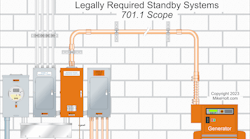A basic electrical theorem says the amount of current that will flow through a short circuit depends on two variable values: The system voltage and the connected total impedance of the current flow path from the source to the point of the fault.
The typical system voltages are very familiar to all of us. The connected total impedance of the short-circuit current flow path needs a little clarification, however. This impedance normally includes the feeder conductors' resistance and reactance, any transformers' impedances (going from the point of fault back to the energy source), and any other equipment connected in the path of current flow.
Fig. 1 is a very simple one-line with the following: a power source, transformer, and an overcurrent protective device (OCPD) having a specific short-circuit current interrupting rating.
Let's talk about the power source first. In many short-circuit current calculation examples, you'll see references like "Assume the power source has infinite capacity" or "The source has an infinite bus." What does this mean, and why is it important to sample calculation? All that is being said is the source voltage has no internal impedance. As a result, the sample calculation becomes very conservative. Since the source has been assumed to have no impedance of its own, the corresponding short-circuit current will be at its worst case.
Now let's look at the transformer. The impedance determining the amount of short-circuit current on its secondary is made up of two separate impedances: Its own impedance plus that of the secondary conductors run to the point of the fault. The transformer's own impedance is the amount of its opposition to the flow of short-circuit current through it.
Now, all transformers have impedance, and it's generally expressed as a voltage percentage. This is the percentage of normal rated primary voltage that must be applied to the transformer to cause full-load rated current to flow in the short-circuited secondary. For instance, if a 480V/120V transformer has an impedance of 5%, this means that 5% of 480V, or 24V, applied to its primary will cause rated load current flow in its secondary. If 5% of primary voltage will cause such current, then 100% of primary voltage will cause 20 times (100 divided by 5) full-load-rated secondary current to flow through a solid short circuit on its secondary terminals. Obviously, then, the lower the impedance of a transformer of a given kVA rating, the higher the amount of short-circuit current it can deliver.
Let's take another example for clarification. Suppose we have two transformers, each rated at 500kVA. Since they have the same rating, each has the same rated secondary load current. Suppose one of the units has a 10% impedance. It, therefore, can supply 10 times (100 divided by 10) its rated secondary load current into a short circuit on its secondary terminals. Now suppose the second unit has an impedance of 2%. This unit can supply a much greater multiple of its rated secondary load current into a short circuit on its secondary terminals: 50 times (100 divided 2) this value. Comparing both units, the latter transformer can deliver five times as much short-circuit current as the former unit.
Sample calculation Now that we understand the basic variables that determine short-circuit currents, let's do a sample calculation. As shown in Fig. 2, suppose we have a simple distribution system with a fault condition. For the sake of clarity and simplification, let's assume there are negligible line impedances between the transformer secondary and the fault.
Step 1. Determine full-load secondary current (IsubS). IsubS = 100,000VA/240V = 417A
Step 2. Determine the short-circuit current (IsubSC) at the transformer's secondary terminals per its impedance. IsubSC * (100% / %ZsubT) x IsubS = (100/2.5) * 417 = 16,680A
Therefore, the OCPD must be capable of safely interrupting this amount of current, along with the asymmetrical current value (usually a multiplier times the symmetrical value).
Admittedly, this is greatly simplified. In reality, the calculation would consider all impedances and the distance of the fault relative to the transformer. Nevertheless, it gives you a feel for what is involved in short-circuit current analysis.


